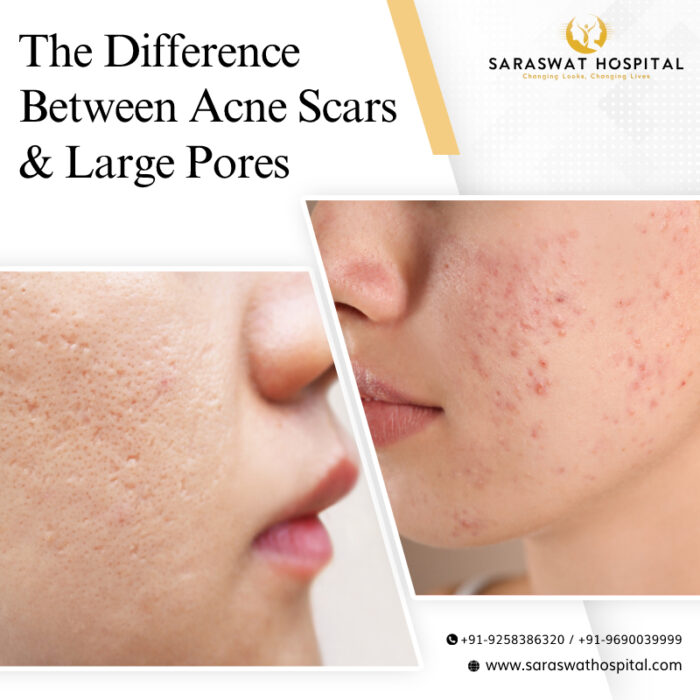One of the most important parts of staying healthy is taking good care of the skin. While the cleansing-toning-moisturizing (CTM) routine is always suggested to keep your skin healthy, more often than not, people are unaware of what exactly the skin wants. This also makes people use the wrong skincare products, making them prone to skin problems. The two common problems that most people deal with but cannot differentiate between are acne scars and large pores, the treatment for which is distinct as well. Through this blog, we will find out how to understand the difference between the two and the best ways to treat them.
What Are Acne Scars and Large Pores?
Acne scars are permanent marks left on the skin after severe or persistent acne. They occur when the skin’s healing process is disrupted, often due to inflammation or damage to deeper layers of the skin (the dermis).
Large pores are visible openings in the skin where hair follicles and oil glands (sebaceous glands) are located. Pores can appear enlarged due to excess oil production, genetics, aging, or clogged debris like dead skin cells and sebum. Unlike acne scars, large pores are not caused by skin damage but are a natural feature of the skin that can become more prominent under certain conditions.
Key Differences Between Acne Scars and Large Pores
To effectively treat your skin concerns, it’s crucial to distinguish between acne scars and large pores. Here’s how they differ:
1. Appearance:
Acne Scars: These appear as indented, raised, or discolored marks. They may have irregular shapes or textures, such as pits or ridges, and are often concentrated in areas where acne was severe.
Large Pores: These look like small, uniform, round openings on the skin, often resembling an orange peel texture. They are typically most noticeable in oily areas like the T-zone (forehead, nose, and chin).
2. Texture:
Acne Scars: The skin may feel uneven, bumpy, or pitted due to collagen loss or overproduction. Scars can be deep or shallow, but always alter the skin’s surface.
Large Pores: The skin around large pores is usually smooth but may feel slightly oily or rough due to clogged debris.
3. Cause:
Acne Scars: Result from inflammation or injury caused by acne, particularly cystic or nodular acne, which damages the skin’s deeper layers.
Large Pores: Caused by genetics, excess sebum production, aging (loss of skin elasticity), or environmental factors like sun damage.
4. Location:
Acne Scars: Found in areas where acne breakouts occurred, such as the cheeks, chin, or forehead.
Large Pores: Commonly appear in oily areas like the nose, forehead, and chin, but can be present across the face.
5. Color:
Acne Scars: May be red, brown, or hyperpigmented (PIH) or appear as colorless indentations.
Large Pores: Usually match the skin tone but may look darker if clogged with dirt or oil.
How to Identify Large Pores & What Causes Them?
Everyone has pores on the skin that help to release toxins from the body to keep the skin soft. However, those with acne-prone, combination, or oily skin often see large pores on the surface. This can be caused by the excessive production of sebum, sun damage, application of too much makeup, squeezing blackheads, or using the wrong skin care products.
What are Acne Scars & How to Identify Them?
Acne scars, on the other hand, are deep and shallow depressions on the skin that show up only after you have gone through a severe active acne breakout. This happens when the dermis is damaged due to acne, and the new tissue formation with collagen fibres during the healing process has misaligned levels. Acne scars can be found in icepick, boxcar, raised, and depressed variants.
What are the Best Ways to Treat Them?
If you have had a severe acne outbreak in recent times and are then seeing depressions on the skin, that is when you are suffering from acne scars. Large pores, as mentioned earlier, are caused by excessive sebum production and not active acne. When you have identified the condition, you must contact professionals to treat it.
Acne scar treatment is performed in various ways, such as Microneedling (where tiny wounds are created on the skin to produce more collagen), Laser Rejuvenation (where a certain wavelength of laser light is used to improve the elasticity of the skin), Chemical Peels, and Dermarollers. Depending on the type of acne scar you’re suffering from, the professional will follow a customized treatment procedure for the most natural-looking results.
Why Should You Get in Touch with Saraswat Hospital?
Saraswat Hospital is one of the most popular clinics run by international board-certified surgeons that offer customized acne scar treatment using modern technology and the latest equipment to get the best results.
As the Chief Clinical Cosmetologist of the hospital, Dr Preeti Saraswat is an MBBS with a Post Graduate Diploma degree in Clinical Cosmetology from the University of Greifswald, Germany. She has a lifetime membership of the Indian Association of Cosmetic Laser Surgeons and is also a member of the Indian Medical Association, ensuring that she stays updated with all the latest developments in the field to provide the best results to her patients.
Dr Satya Kumar Saraswat is an MBBS with MS, M.Ch, and DNB (Plastic Surgery) degrees to his credit. As a member of several international boards, Dr Saraswat has left his mark in the plastic surgery sector. He is known to specialize in various kinds of hair restoration surgeries and has also presented his take on a modified FUT technique at the 24th World Congress of ISHRS.
Conclusion
Distinguishing between acne scars and large pores is essential for effective skincare. If you’re suffering from acne scars or large pores, it is crucial for you to get in touch with an expert to treat them before they get any worse. Saraswat Hospital is led by two of the most prominent doctors in the field who offer the best acne scar treatment in India. To know more details, you can book a consultation at Saraswat Hospital today.


